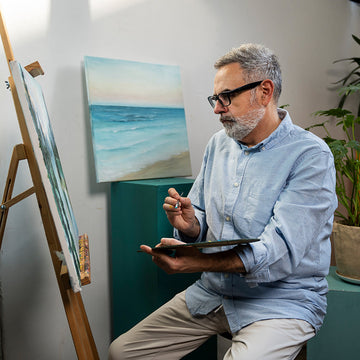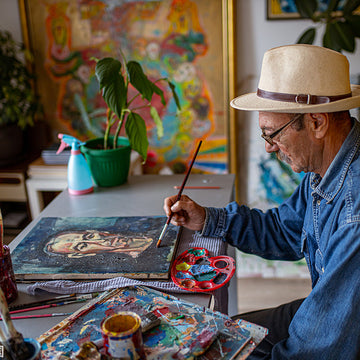🌿 The Origins of Wabi-Sabi Aesthetics
Mia grew up in a home deeply influenced by the philosophy of Wabi-sabi. Her mother often told her, “Every crack, every mark of wear, is a poem written by time.” With microcement walls, a wooden table marked by natural knots, and dried reeds resting in clay pots, Mia learned early on that true beauty lies not in perfection, but in simplicity, authenticity, and quiet strength.

🎨 From Calm to Passion
In her final year of high school, overwhelmed by academic pressure, Mia casually sketched a clay pot from her home. As the muted grays and rough textures emerged on the canvas, she felt an unfamiliar but profound sense of peace. That moment led her to pursue art. At the Academy of Fine Arts, instead of chasing trends, she chose patience and discipline, refining her craft to discover her own visual language.

🖌️ A Signature Technique
Mia’s paintings are defined by the fusion of two contrasting techniques:
-
Glazing: delicate, translucent layers of color that create a serene, time-worn glow, like a veil of silence across the canvas.
-
Impasto: bold, textured strokes that bring to life cracks, erosion, and weathered surfaces, tangible as if sculpted by time.
This dialogue between softness and strength gives her works a unique tension—serene from afar, yet richly tactile up close. It is this duality that has made her paintings stand out as striking focal points in spaces, admired by designers and collectors alike.

🕰️ Timeless Works Worth Collecting
In her small studio in the old quarter, Mia continues to paint what she knows best: her mother’s worn sweater, driftwood eroded by waves, tea bowls with uneven glaze and kiln cracks. Each piece is more than an object—it is a quiet corner for reflection, a reminder that beauty resides in the traces of time. She often says: “I don’t paint flaws. I paint the passage of time.”
For collectors, her works are not just decorative pieces, but soulful experiences—timeless impressions worth preserving.





